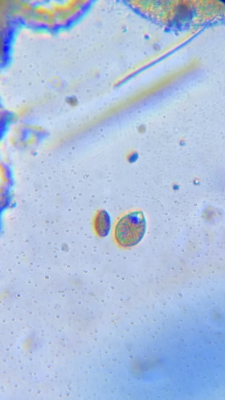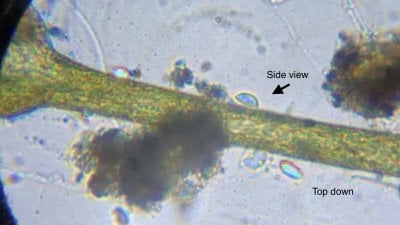- Joined
- May 22, 2016
- Messages
- 6,970
- Reaction score
- 10,747
Follow along with the video below to see how to install our site as a web app on your home screen.
Note: This feature may not be available in some browsers.
I've had this laying around for a while. Had some recent interest, so I tweaked it a bit and am posting it.
Not really about cures just ID pictures, videos, and a few short facts.
Hope it can be helpful.
haha. Well, it's true that I have lots of projects on various back burners, but this is mostly posted to communicate to everyone what those of us who ID are looking for.If this becomes a sticky, what are you going to do with all your spare time? (Please go back to work on cyano hint hint.)
@taricha
Can i ask you if this are Ostreopsis or Amphidinium to understand what's better for my tank?
Thanks
Is UV lamp the solution?
I've a 125G dsb tank, is it dangerous to use? If not, i've in cellar a 20w UV lamp. It' s enough?
Thanks for yuour answer
Yes. Sometimes they can grow quite heavily. But don't assume any nutrient similarities to dino just because of the appearance.They don't seem to be spreading rapidly but just wondering if you've ever heard of these becoming a problem in people's tanks?
two good chrysophyte threads:

Chrysophytes, AKA "Golden Algae" - How to identify, treat and remove it from your tank!
A wikipedia image for chrysophytes. For some time, I've been dealing with a mystery ailment in my aquarium. A wispy, slimy mass grew on almost every exposed area of my tank - no matter what I had tried, it kept coming back and stubbornly stuck with me for months. I started my current tank in...www.reef2reef.com

Chrysophytes?! Help me cure it?
Chrysophyta (golden-brown algae) The Chrysophyta are the golden-brown algae and diatoms, which respectively account for 1,100 and 40,000-100,000 species of unicellular algae. These algae occur in both marine and fresh waters, although most species are marine. The cell walls of golden-brown algae...www.reef2reef.com

The pattern you described is the classic one: drastic swings in nutrients. First it is cyano, then dinos. The Chemiclean seals the deal. I've read the same story in the "Are you tired" thread >100 times.Thank you for this!! Looks like I have Ostreopsis Dino. Looking for battle advice... Long story short, my tank had cycled but was still immature (5 mo) and a family member over fed (~10x normal) while we were on vacation. Nitrate spiked from a stable .5 (from side of salifert kit, matched with 5) to 50+ ppm (from top). After multiple water changes and months of minimal feeding I got them to reduce and stabilize at ~5 ppm. A few mo later I had a massive Cyano bloom (red, came off in sheets) that I battled via manual removal in hopes it would go away over time. Battled for 1.5 mo. Eventually it grew in so thick that it was covering patches of zoa and I used Chemiclean after a thorough manual removal. After a 25% water change I began dosing MB7 to establish beneficial bacteria. About a week later the Cyano returned and another Chemiclean treatment was initiated. During treatment I noticed a new Dino bloom in long strings with bubbles. Although I know I should not do water changes in order to slow the Dino down, I had to again per Chemiclean instructions. I am now post second 25% water change and hoping to beat Dino now that Cyano appears to be gone. I have continued to manually remove any Dino strings I find and have began to use Dino X due to how heavy and quickly the Dino appeared. Dino X advised no carbon and wet skimming to increase likelihood of product impact. My plan forward is to continue dosing MB7 while battling Dino with Dino X (skimmer off for 4 hr during MB7 dose) as needed and to keep feeding schedule the same in order to keep nitrate ~5 ppm. Please send any other recommendations any of you may have.
Mixed reef
IM Nuvo 30L
IM midsize DC skimmer
Ample flow (Jebao & Koralia Nano 240)
Carbon (paused while using Dino X)
Parameters after H2O change w reef crystals
Sal 1.024
Temp 76 avg
Alk 9.8 (letting drop back down to ~9)
Ca 390 (slowly raising to ~420)
Mg 1170 (dropped after H2O Ch, slowly raising to 1300-1350)
PH 8
Nitrate 5ppm
Phosphate ~0, hard to tell with API
1 Wrasse and 2 clown all healthy
Multiple snails and hermits
GHA bloom as well, keeping at it manually.
Please send recommendations, I know time is the most valuable asset but the Cyano and Dino really came in heavy and quick and we’re taking over my LPS & SPS. Already big on husbandry as well.

Much love Scott! Thank youThe pattern you described is the classic one: drastic swings in nutrients. First it is cyano, then dinos. The Chemiclean seals the deal. I've read the same story in the "Are you tired" thread >100 times.
Good news: Ostreos are easy to treat. Bad news: they are fairly toxic and tough on the corals that are weakend by the lack of nutrient -- PO4 particularly.
1) Start dosing PO4 immediately. Seachem Flourish or NeoPhos are fine premixes. You can take the dosing instructions provided and double them -- even triple them in the first few days -- as your rock and substrate will bind the first 50ml or so.
2) Once you have a steady PO4 reading of .08 or so, you can begin dosing NO3: Neonitro is fine
3) Order a UV pronto. 1 watt per 3 gallons. You can get the Green Killing machine, but it will rust within a month and you should chuck it. Aqua UV makes a much better unit that you can run forever. This needs to run in/out of the display itself, not the sump. Slow flow.
4) Manual removal: clip some sheets of filter floss to the sides of the glass in high flow high light areas where dinos like to be. Rinse each evening.
6) Run activated carbon. Replace often. Toxin removal.
7) No phyto, no aminos, no coral foods. Feed the fish only.
For testing:
PO4 you must have a Hanna ULR (phosphate or phosphorus) Target: .1
NO3 I prefer NYOS, but most of the tests are OK. Target: 10
Once the UV is running, and the nutrients are measurable, you should see results within 3-4 days. Keep dosing and testing. Once you see the cyano return (it will) keep going. Syphon out the cyano.
Don't stop until your microscope tells you it is OK.


